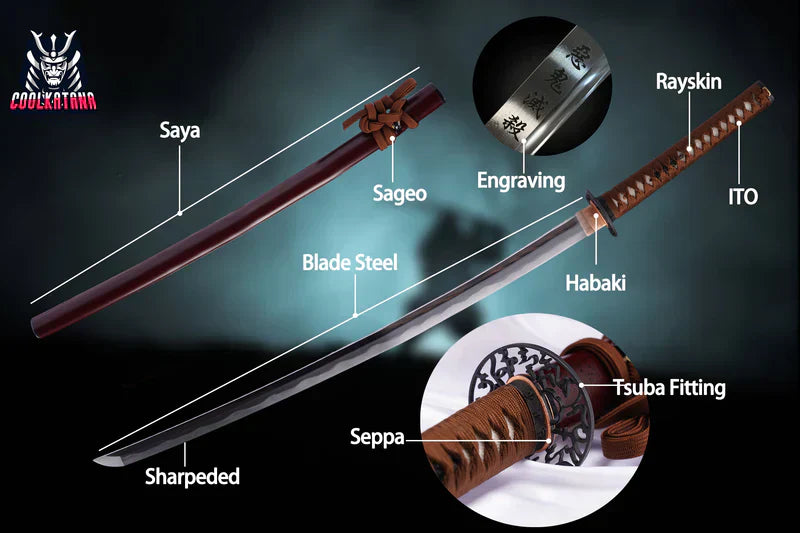Mastering Sword Anatomy: The Art and Function of Battle-Ready Blades

Samurai Sword Anatomy
Mastering the anatomy of a samurai sword helps us appreciate the craftsmanship of Japanese swordsmiths. The blade is called a Japanese katana, made from durable high carbon steel. Key features include the shinogi ji (the flat surface between the ridge and edge), the distinct hamon line that shows the blade’s tempering, and the strong ridge line that adds structural support to the sword blade. The tsuka ito, or handle wrap, provides grip and control, while the blade collar secures the blade to the handle. This design has evolved over a long time, blending beauty with battle-ready function.
In the captivating world of anime, battle-ready samurai swords hold an esteemed place as symbols of protection, honor, and valor. Wielded by valiant samurai warriors, these magnificent blades are not only a testament to the craftsmanship of skilled swordsmiths but also an embodiment of the warrior's spirit. As we delve into the anime world, we unravel the anatomy of battle-ready samurai swords and their significance in protecting the ideals of the characters they accompany.
The Legendary Katana - An Emblem of Defense and Offense
The katana, the most renowned among battle-ready samurai swords, serves as an emblem of defense and offense. In anime series like 'Naruto,' characters like Sasuke Uchiha and Itachi Uchiha wield katanas with mastery, employing them to protect their loved ones and strike down their adversaries. The katana's long, single-edged blade allows for precise strikes and deadly cuts, making it a weapon of choice for both defense and offense. Its versatile design and inherent strength symbolize the samurai's capability to protect what they hold dear while defending their ideals with unyielding determination.

The Craftsmanship of the Blade - Forging Strength and Resilience
The anatomy of battle-ready samurai swords is a product of meticulous craftsmanship. Skilled swordsmiths in anime series like 'Samurai Champloo' and 'Rurouni Kenshin' demonstrate the traditional process of forging the perfect blade. The construction of a katana involves the careful layering and folding of steel, ensuring the blade's strength and resilience. The curve of the blade, known as the sori, gives the katana its iconic shape, enhancing its cutting power. The sharp edge, called the ha, and the ridge running along the blade, known as the shinogi, contribute to the katana's formidable cutting ability.
The Guard and Hilt - Safeguarding the Warrior

In addition to the blade, the anatomy of a battle-ready samurai sword includes the guard and hilt. The guard serves to protect the samurai's hand and acts as a barrier against enemy strikes, while the hilt allows for a secure grip and control of the sword during combat. Anime series like 'Sword Art Online' and 'Samurai 7' depict the significance of the guard and hilt in protecting the warrior during intense battles. The design and materials of these components not only contribute to the sword's aesthetic appeal but also ensure the safety and efficiency of the samurai's movements.

The scabbard's design and material ensure a snug fit for the blade, preventing it from rattling and reducing the risk of injury to the samurai. The scabbard's decorative elements also contribute to the sword's overall aesthetic appeal, making it a work of art in addition to a formidable weapon. In conclusion, the anatomy of battle-ready samurai swords in the anime world goes beyond a mere weapon; it symbolizes protection and valor. The katana, with its defensive and offensive capabilities, represents the resilience and determination of the samurai warrior. As we immerse ourselves in the captivating stories of anime, the battle-ready samurai sword becomes more than just a physical entity; it becomes an embodiment of the samurai's spirit, protecting their ideals and safeguarding what they hold dear in the anime universe.






